chipmunkofdoom2
Always Making Something
View BadgesExcellence Award
Article Contributor
Reef Squad Emeritus
I recently ordered some aquacultured (read: from the ocean) live rock from KP Aquatics. I started my tank with dry rock and have had trouble with nuisance algae and nutrients the entire two years the tank has been running. SPS might survive, but they certainly don't thrive or grow an appreciable amount. I'm tired of the struggle. I figured it was time for the nuclear option: buy ocean rock, cure it, and replace all the rock in my DT with the ocean rock.
I ordered a 10lb box of live rock from KP Aquatics. I chose KP Aquatics for several reasons. First, they overnight the rock. I didn't feel like air freighting. In a smaller tank, air freighting doesn't make a ton of sense. Second, KP Aquatics offer relatively small quantities of rock. They offer 10lb boxes overnighted, which turns out to be a perfect amount. I think it's just enough rock for my 20 gallon long, although I like a bit of a more empty look in my tanks.
The rock was shipped late in the day on a Monday and I received it by 11:00AM the next day. I took the rock out of the box and into my curing system it went. There's a ton of life on the rocks. Lots of coralline, what looks like a small scallop, and a few feather dusters. I saw a tiny starfish the first day I put the rock in the tank, and there was a small mantis shrimp left in the bag after I had taken out all the rock, but other than that, I haven't seen much large fauna. I'm sure there are some live critters there... they might just be hiding in the rock. There was a rather large dead brittle star inside one of the holes on the rock. While only time will tell if this is true, I think overnighting ocean rock might be the best option in terms of pest management. Larger more complex animals (like the big britle star or the mantis shrimp in the bag) appear to not like being out of water for 16+ hours. While this might reduce biodiversity, it could potentially weed out large and undesirable pests like mantis shrimps and crabs.
Had I known about KP Aquatics when I started my tank in January of 2016, I probably would have started my tank with their live rock instead of the dry rock. For only $108, a box of beautiful and very live rock came straight to my door. We're still learning as a hobby, but it appears that many problems we have in modern reef aquarium keeping, such as dinoflagellates or poor SPS growth, are caused at least in part (if not in whole) by an incomplete biological system. Since we made the switch to dry rock, I think in some cases we've made our tanks too clean and sterile. In some dry rock systems, it takes an incredibly long time to mature. We have fewer hitchhikers and less nuisance alage like bryopsis now, but we've also made it much more difficult for tanks to mature. Is it worth it? Have we thrown out the baby with the bath water? I don't know. That depends on the reefer and how quickly the dry rock tank matures. I think I'm ready to take the bad with the good and see how my fortunes play out.
But, all that is a discussion for another thread at another time. We still have a very poor understanding of what makes a tank "mature" or "successful." Here are a few pictures of the rock. My phone is having trouble representing the colors of the rock accurately, but it's covered in orange, green, purple, pink and red coralline. It's truly beautiful rock. I'll update as the rock cures, as well as how my display behaves when I swap out the dry rock for the live rock.
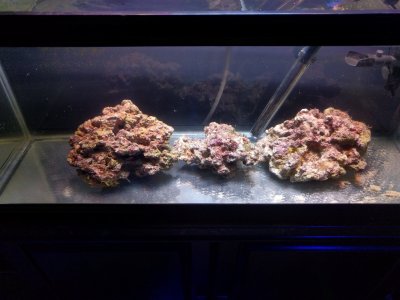
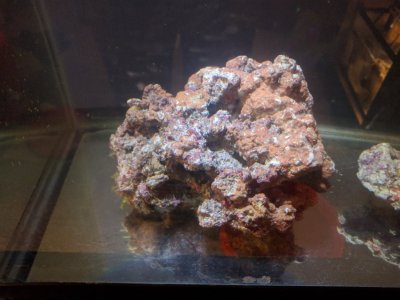
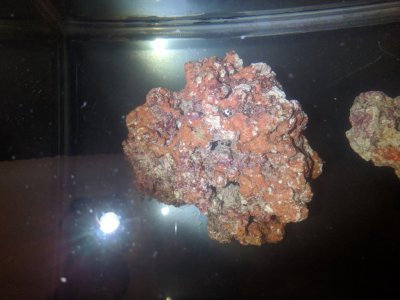
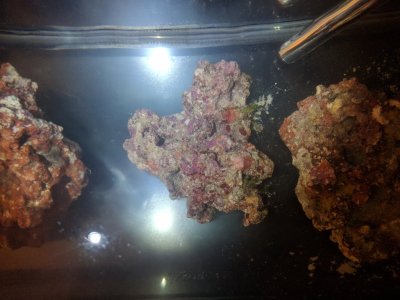
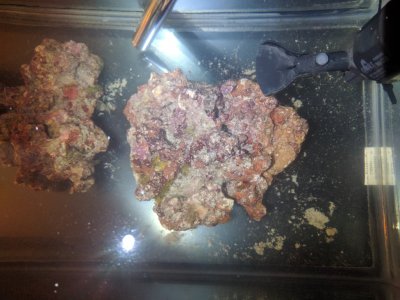
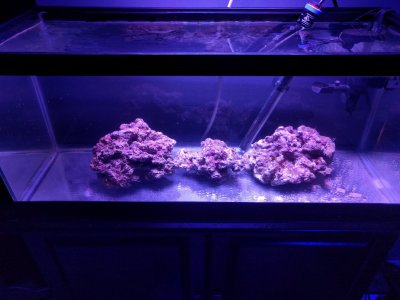
I ordered a 10lb box of live rock from KP Aquatics. I chose KP Aquatics for several reasons. First, they overnight the rock. I didn't feel like air freighting. In a smaller tank, air freighting doesn't make a ton of sense. Second, KP Aquatics offer relatively small quantities of rock. They offer 10lb boxes overnighted, which turns out to be a perfect amount. I think it's just enough rock for my 20 gallon long, although I like a bit of a more empty look in my tanks.
The rock was shipped late in the day on a Monday and I received it by 11:00AM the next day. I took the rock out of the box and into my curing system it went. There's a ton of life on the rocks. Lots of coralline, what looks like a small scallop, and a few feather dusters. I saw a tiny starfish the first day I put the rock in the tank, and there was a small mantis shrimp left in the bag after I had taken out all the rock, but other than that, I haven't seen much large fauna. I'm sure there are some live critters there... they might just be hiding in the rock. There was a rather large dead brittle star inside one of the holes on the rock. While only time will tell if this is true, I think overnighting ocean rock might be the best option in terms of pest management. Larger more complex animals (like the big britle star or the mantis shrimp in the bag) appear to not like being out of water for 16+ hours. While this might reduce biodiversity, it could potentially weed out large and undesirable pests like mantis shrimps and crabs.
Had I known about KP Aquatics when I started my tank in January of 2016, I probably would have started my tank with their live rock instead of the dry rock. For only $108, a box of beautiful and very live rock came straight to my door. We're still learning as a hobby, but it appears that many problems we have in modern reef aquarium keeping, such as dinoflagellates or poor SPS growth, are caused at least in part (if not in whole) by an incomplete biological system. Since we made the switch to dry rock, I think in some cases we've made our tanks too clean and sterile. In some dry rock systems, it takes an incredibly long time to mature. We have fewer hitchhikers and less nuisance alage like bryopsis now, but we've also made it much more difficult for tanks to mature. Is it worth it? Have we thrown out the baby with the bath water? I don't know. That depends on the reefer and how quickly the dry rock tank matures. I think I'm ready to take the bad with the good and see how my fortunes play out.
But, all that is a discussion for another thread at another time. We still have a very poor understanding of what makes a tank "mature" or "successful." Here are a few pictures of the rock. My phone is having trouble representing the colors of the rock accurately, but it's covered in orange, green, purple, pink and red coralline. It's truly beautiful rock. I'll update as the rock cures, as well as how my display behaves when I swap out the dry rock for the live rock.






Last edited:


















